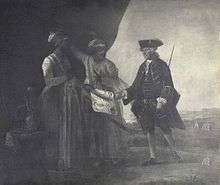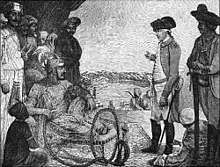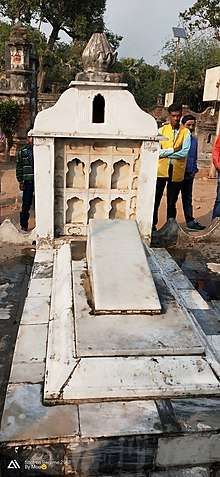Mir Jafar
Syed Mir Jafar Ali Khan Bahadur (Bengali: সৈয়দ মীর জাফর আলী খান বাহাদুর, Persian: سید میر جعفر علی خان بہادر; c. 1691 – 5 February 1765) was a military general who became the first dependent Nawab of Bengal of the British East India Company. His reign has been considered to be the start of British imperialism in Indian history and a key step in the eventual British domination of vast areas of the Indian subcontinent.
| Jafar Ali Khan Bahadur | |||||
|---|---|---|---|---|---|
| Nawab of Bengal | |||||
_and_Mir_Miran_(right).jpg) Mir Jafar (left) and his eldest son, Mir Miran (right). | |||||
| 6th Nawab Nazim of Bengal, Bihar and Orissa | |||||
| 1st reign | 2 July 1757 – 20 October 1760 | ||||
| Predecessor | Siraj ud-Daulah | ||||
| Successor | Mir Qasim | ||||
| 2nd reign | 25 July 1763 – 5 February 1765 | ||||
| Predecessor | Mir Qasim | ||||
| Successor | Najimuddin Ali Khan | ||||
| Born | 1691 | ||||
| Died | 5 February 1765 (aged 73–74) Bengal | ||||
| Burial | |||||
| Spouse | Shah Khanum Sahiba (m. 1727, d. August 1779) Munni Begum (noble) (m. 1746, d. 10 January 1813) Rahat-un-nisa Begum (Mut'ah wife) Babbu Begum (d. 1809) | ||||
| Issue | Sadiq Ali Khan Bahadur (Mir Miran) Najimuddin Ali Khan | ||||
| |||||
| House | Najafi | ||||
| Father | Sayyid Ahmed Najafi (Mirza Mirak) | ||||
| Religion | Shia Islam[1][2][3] | ||||
Mir Jafar served as the commander of Bengali forces under Siraj ud-Daulah, the Nawab of Bengal, but betrayed him during the Battle of Plassey and succeeded him after the British victory in 1757. Mir Jafar received military support from the British East India Company until 1760, but failed to satisfy various British demands. In 1758, Robert Clive discovered that Jafar had made a treaty with the Dutch at Chinsurah through his agent Khoja Wajid. Dutch ships of war were also seen in the River Hooghly. Circumstances led to the Battle of Chinsurah. British company official Henry Vansittart proposed that since Jafar was unable to cope with the difficulties, Mir Qasim, Jafar's son-in-law, should act as Deputy Subahdar. In October 1760, the company forced him to abdicate in favor of Qasim. However, Qasim's independent spirit and plans to force the East India company out of his dominion led to his overthrow, and Jafar was restored as the Nawab in 1763 with the support of the company. Mir Qasim however refused to accept this and went to war against the company. Jafar ruled until his death on 5 February 1765 and lies buried at the Jafarganj Cemetery in Murshidabad, West Bengal. Mir Jafar remains a controversial figure in Indian history and became a symbol of intimate betrayal or treachery among Bengalis.
Subedar of the Nawab of Bengal
In 1747 the Maratha Empire led by Raghoji I Bhonsle, began to raid, pillage and annex the territories of the Alivardi Khan, the Nawab of Bengal. During the Maratha invasion of Odisha, its subedar Mir Jafar and Ataullah the faujdar of Rajmahal completely withdrew all forces until the arrival of Alivardi Khan and the Mughal Army at the Battle of Burdwan where Raghoji I Bhonsle and his Maratha forces were completely routed. The enraged Alivardi Khan then dismissed the shamed Mir Jafar.[4]
Nawab of Bengal

Jafar initially showed loyalty to Alivardi Khan's successor Siraj Ud Daulah, but betrayed him to the British in the battle of Plassey.[5] After Siraj Ud Daulah's defeat and subsequent execution, Jafar achieved his long-pursued dream of gaining the throne, and was propped up by the British East India company as puppet Nawab. Jafar paid Rs. 17,700,000 as compensation for the attack on Calcutta to the company and traders of the city. In addition, he gave bribes to the officials of the company. Clive, for example received over two million rupees, Watts over one million.[6] Soon, however, he realized that company's expectations were boundless and tried to wriggle out from under them; this time with the help of the Dutch. However, the British defeated the Dutch at the Battle of Chinsurah in November 1759 and retaliated by forcing him to abdicate in favor of his son-in-law Mir Qasim. Qasim proved to be both able and independent, strongly condemned the interference of the East India company in governing his domain. Mir Qasim formed an alliance to force the British East India company out of East India. The Company soon went to war with him and his allies. The Battle of Buxar was fought on 22 October 1764 between the forces under the command of the British East India Company led by Hector Munro, and the combined armies of Mir Qasim the Nawab of Bengal, Shuja-ud-Daula the Nawab of Awadh, and the Mughal Emperor Shah Alam II. With the defeat in Buxar, Mir Qasim was eventually overthrown. Mir Jafar managed to regain the good graces of the British; he was again installed Nawab in 1764 and held the position until his death in 1765.
Bengal War

Imad-ul-Mulk's letter to Mir Jafar, after the escape of the Mughal crown prince Ali Gauhar.[7]
In 1760, after gaining control over Bihar, Odisha and some parts of the Bengal, the Mughal Crown Prince Ali Gauhar and his Mughal Army of 30,000 intended to overthrow Jafar, Imad-ul-Mulk after they tried to capture or kill him by advancing towards Awadh and Patna in 1759. But the conflict soon involved the assertive British East India Company. The Mughals were led by Prince Ali Gauhar, who was accompanied by Muhammad Quli Khan, Hidayat Ali, Mir Afzal and Ghulam Husain Tabatabai. Their forces were reinforced by the forces of Shuja-ud-Daula and Najib-ud-Daula. The Mughals were also joined by Jean Law and 200 Frenchmen and waged a campaign against the British during the Seven Years' War.[8]
Although the French were eventually defeated, the conflict between the British East India Company and the Mughal Empire would continue to linger and ended in a draw, which eventually culminated during the Battle of Buxar.
Legacy

The breakup of the centralized Mughal empire by 1750, led to creation of a large number of independent kingdoms in Northern, Central and Western India, as also North-Western India (now Pakistan) and parts of Afghanistan (all provinces of the former Mughal empire). Each of them were in conflict with their neighbor. These kingdoms bought weapons from the British and French East India companies to fuel their wars. Bengal was one such kingdom. The British and French supported whichever princes ensured their trading interest. Jafar came to power with support of British East India company. After the defeat of Sirajuddoula and later Mir Qasim the British strengthened their position in Bengal and in 1793 abolished Nizamat (Mughal suzerainty) and took complete control of the former Mughal province. The word "mirjafar" in Bengali and the phrase "meer jafar" in Urdu, are used much as quisling is used in English, and Jaichand of Kannauj in North Indian history.[9][10]

See also
- Namak Haram Deorhi
- Great Britain in the Seven Years War
Notes
- ^ "Riyazu-s-salatin", Ghulam Husain Salim – a reference to the appointment of Mohanlal can be found here
- ^ "Seir Muaqherin", Ghulam Husain Tabatabai – a reference to the conspiracy can be found here
- A website dedicated to Mir Jafar
References
- S. A. A. Rizvi, A Socio-Intellectual History of Isna Ashari Shi'is in India, Vol. 2, pp. 45–47, Mar'ifat Publishing House, Canberra (1986).
- K. K. Datta, Ali Vardi and His Times, ch. 4, University of Calcutta Press, (1939)
- Andreas Rieck, The Shias of Pakistan, p. 3, Oxford University Press, (2015).
- Jaques, Tony (2007). Dictionary of Battles and Sieges: A-E. Greenwood Publishing Group. ISBN 9780313335372.
- Mohammad Shah (2012), "Mir Jafar Ali Khan", in Sirajul Islam and Ahmed A. Jamal (ed.), Banglapedia: National Encyclopedia of Bangladesh (Second ed.), Asiatic Society of Bangladesh
- Modern India by Dr. Bipin Chendra, a publication of National council of Educational Research and Training
- Royal Asiatic Society of Great Britain and Ireland (1852). Journal of the Royal Asiatic Society, Volume 13. University Press. pp. 123–.
- O`malley, L.S.S. Bihar And Orissa District Gazetteers Patna. Concept Publishing Company, 1924. ISBN 9788172681210.
- Ahsan, Syed Badrul (31 October 2005). "Iskandar Mirza, Ayub Khan, and October 1958". New Age. Dhaka. Archived from the original on 19 August 2007.
- Buyers, Christopher. "Murshidabad family information". The Royal Ark. Archived from the original on 25 April 2006.
External links
- "Riyazu-s-salatin", A History of Bengal, Ghulam Husain Salim (translated from the Persian): viewable online at the Packard Humanities Institute
- Mir Jafar Ali Khan in Banglapedia
- Humayun, Mirza (2002). From Plassey to Pakistan. Washington D.C.: University Press of America; Revised edition (28 July 2002). ISBN 0-7618-2349-2.
- Murshidabad History-Mir Muhammad Jafar Ali Khan